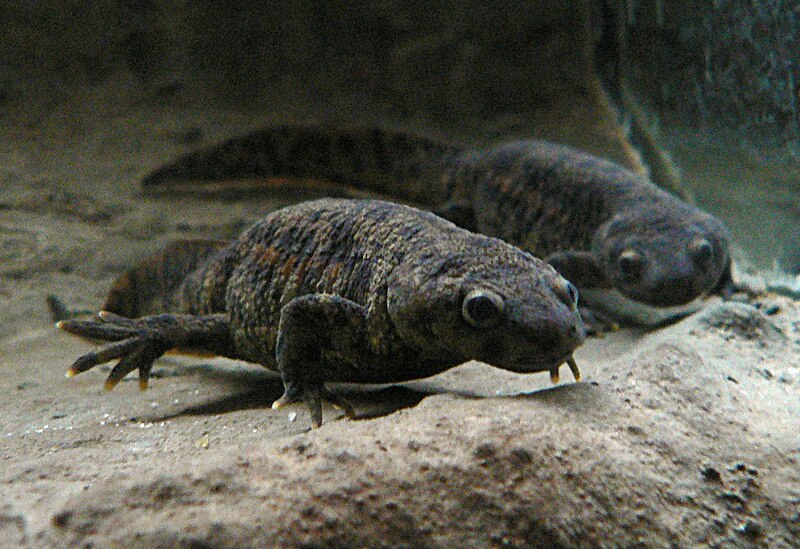Male Great Crested Newts undergo an amazing change in appearance during the breeding season. In Part I of this article I introduced the natural history of this most beautiful newt, and discussed how to bring it into breeding condition. I’ll cover breeding details and raising the larvae here.
Courtship and Egg Deposition
Breeding male newts tend to fight and, although severe damage is rarely inflicted, less dominant animals may become stressed and cease feeding. Courting males position themselves near females and appear to direct pheromones towards them with their tails. Females thus stimulated follow the males, push against their tails, and eventually pick up the spermatophore that the male has dropped.
Several hundred eggs are laid, each being individually attached to an aquatic plant. Females use their rear legs to bend a plant leaf around each egg – quite an ordeal, and well-worth watching!
Adults may consume eggs and so should be removed from the aquarium after egg-laying has been completed. If prevented from returning to land after breeding, adult crested newts usually become quite stressed, thrashing about wildly. Some subspecies, however, can be habituated to a more-or-less permanent aquatic existence.
Raising the Larvae
Crested Newt larvae generally hatch within a month and transform into the terrestrial phase within 3 months, at which point they average 2.4 inches in length.
The larvae can be raised on chopped live blackworms, brine shrimp, daphnia and similar foods; new metamorphs can be offered 10 day old crickets, blackworms, termites and tiny sow bugs. Sexual maturity occurs in approximately two years, at which time they will re-enter water to breed.
An Even More Flamboyant Relative
A close relative, Triturus vittatus ophryticus develops an incredibly high crest that starts at the nose area and ends at the tail. This species is now showing up in the pet trade, and can be bred in a similar manner to the Crested Newt.
Further Reading
Please see a book I’ve written, Newts and Salamanders, for more on the care and natural history of Crested Newts and their relatives.
You can learn more about the natural history of each newt in the genus Triturus here.
Larval Crested Newt image referenced from wikipedia and originally posted by Piet Spaans
 That Reptile Blog – Reptile, Amphibian and Exotic Pet Care and Information
That Reptile Blog – Reptile, Amphibian and Exotic Pet Care and Information


 Anderson’s salamander is part of a complex of similar aquatic, neotenic salamanders which includes the Mexican axolotl (A. mexicanum). Neotenic species retain larval characteristics such as external gills and an aquatic lifestyle upon maturity.
Anderson’s salamander is part of a complex of similar aquatic, neotenic salamanders which includes the Mexican axolotl (A. mexicanum). Neotenic species retain larval characteristics such as external gills and an aquatic lifestyle upon maturity. Originally surfacing in Europe, captive-bred Anderson’s salamanders are now available in the USA as well. This represents a unique opportunity for serious hobbyists to help learn about and conserve an endangered species. As a bonus, Anderson’s salamander is large, beautifully patterned and relatively hardy as well.
Originally surfacing in Europe, captive-bred Anderson’s salamanders are now available in the USA as well. This represents a unique opportunity for serious hobbyists to help learn about and conserve an endangered species. As a bonus, Anderson’s salamander is large, beautifully patterned and relatively hardy as well. You can read more about the natural history of Anderson’s salamander and its relatives at
You can read more about the natural history of Anderson’s salamander and its relatives at  Despite the aforementioned environmental nightmares, the bait trade in tiger salamanders remains largely unregulated, resulting in infected animals being shipped from state to state. This practice hastens the spread of already fast-moving pathogens and of non-native salamanders, as surveys have revealed that most people and bait shops release unused larvae into local waterways.
Despite the aforementioned environmental nightmares, the bait trade in tiger salamanders remains largely unregulated, resulting in infected animals being shipped from state to state. This practice hastens the spread of already fast-moving pathogens and of non-native salamanders, as surveys have revealed that most people and bait shops release unused larvae into local waterways. Tiger salamanders also face serious threats from habitat loss, pollution and the introduction of game fish to breeding ponds. Their use of two distinct habitats – aquatic and terrestrial – renders them especially vulnerable.
Tiger salamanders also face serious threats from habitat loss, pollution and the introduction of game fish to breeding ponds. Their use of two distinct habitats – aquatic and terrestrial – renders them especially vulnerable. Several salamanders have quite unique ways of distributing their protective secretions – fire salamanders (Salamandra salamandra), for example, can squirt theirs for some distance. Perhaps strangest of all, the Spanish ribbed newt (Pleurodeles waltl) actually drives toxin-tipped ribs through the skin of its back when confronted by a predator!
Several salamanders have quite unique ways of distributing their protective secretions – fire salamanders (Salamandra salamandra), for example, can squirt theirs for some distance. Perhaps strangest of all, the Spanish ribbed newt (Pleurodeles waltl) actually drives toxin-tipped ribs through the skin of its back when confronted by a predator!